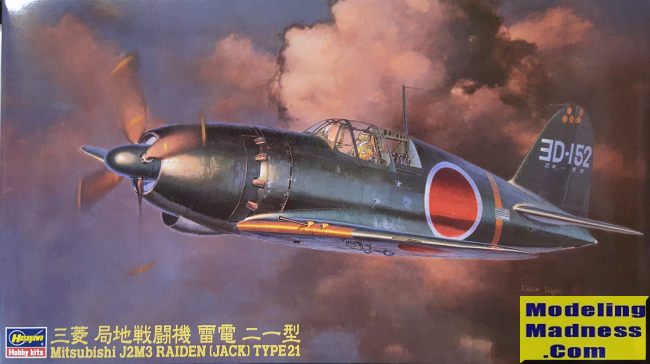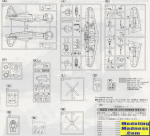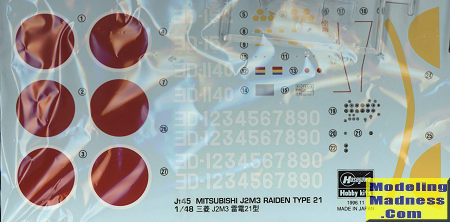
| HISTORY |
Hasegawa 1/48 J2M3 Raiden Type 23
| KIT #: | 09145 (Jt45) |
| PRICE: | 2200 yen when new. Currently available from $32.00 up. |
| DECALS: | Two options |
| REVIEWER: | Scott Van Aken |
| NOTES: | 1996 release |

| HISTORY |
The J2M was designed by Jiro Horikoshi, creator of the A6M Zero, to meet the 14-Shi (14th year of the Showa reign, or 1939) official specification. It was to be a strictly local-defense interceptor, intended to counter the threat of high-altitude bomber raids, and thus relied on speed, climb performance, and armament at the expense of manoeuvrability. The J2M was a sleek, but stubby craft with its oversized Mitsubishi Kasei engine buried behind a long cowling, cooled by an intake fan and connected to the propeller with an extension shaft.
Teething development problems stemming from the Kasei engine cooling system, and the main undercarriage members led to a slowdown in production. The first J2M3s appeared in October 1943 but deliveries to combat units started at the beginning of February 1944.
The Raiden made its combat debut in June 1944 during the Battle of the Philippine Sea. Several J2Ms operated from Guam and Saipan and a small number of aircraft were deployed to the Philippines. Later, some J2Ms were based in Japanese airfields in Korea under Genzan Ku: Genzan (Wonsan); Ranan (Nanam); Funei (Nuren); Rashin (Najin); and Konan, for defense of these areas and fighting against Soviet Naval Aviation units.
Primarily designed to defend against the Boeing B-29 Superfortress, the type was handicapped at high altitude by the lack of a turbocharger. However, its four-cannon armament supplied effective firepower and the use of dive and zoom tactics allowed it to score occasionally.
| THE KIT |
 Prior
to this kit, the only J2Ms produced in this scale were fairly old ones from
Otaki and Tamiya. While both make into nice models, the Hasegawa kit is a
bit nicer due to the more modern tooling.
Prior
to this kit, the only J2Ms produced in this scale were fairly old ones from
Otaki and Tamiya. While both make into nice models, the Hasegawa kit is a
bit nicer due to the more modern tooling.
The cockpit is quite detailed comprising approximately 18 pieces that includes detailed sidewalls and pieces that are attached to those and the cockpit floor. This makes into a full tub that can be installed into the fuselage halves. It appears that the cockpit can be installed after the fuselage halves are closed.
Once this has been done the wings can be assembled. There are holes in the lower wing that can be opened if you want to install the bomb racks. With the wings in place, the gun barrels and pitot can be installed. Then the bombs and the centerline tanks can be assembled. Landing gear are nicely done and once has to install the gear covers prior to installation as it holds the wheels in place.
There is no engine provided, but none is needed as the
cowling is quite closely coupled. With the cowling installed, the individual
exhaust stacks can be installed. This is followed by one of two styles of
propeller. The canopy is a single piece and is installed next along with the
upper fuselage just in front of it.

Instructions are standard fare for Hasegawa with Gunze color references. There are two options, both from the 302nd Naval Flying Group. Both planes are in a dark green over light grey with a black anti-glare panel. The yellow wing leading edges will need to be painted in place. The decal sheet is nicely done and provides a number of additional tail code numbers.
| CONCLUSIONS |
This is the initial boxing of this kit and at least a dozen additional releases of this and other variants have been done. The lack of 'cool' schemes means that it isn't as popular outside Japan as are other kits, however, this should make into a great model.
| REFERENCES |
https://en.wikipedia.org/wiki/Mitsubishi_J2M
July 2022
Copyright ModelingMadness.com. All rights reserved. No reproduction in part or in whole without express permission from the editor.
If you would like your product reviewed fairly and fairly quickly, please contact the editor or see other details in the Note to Contributors.